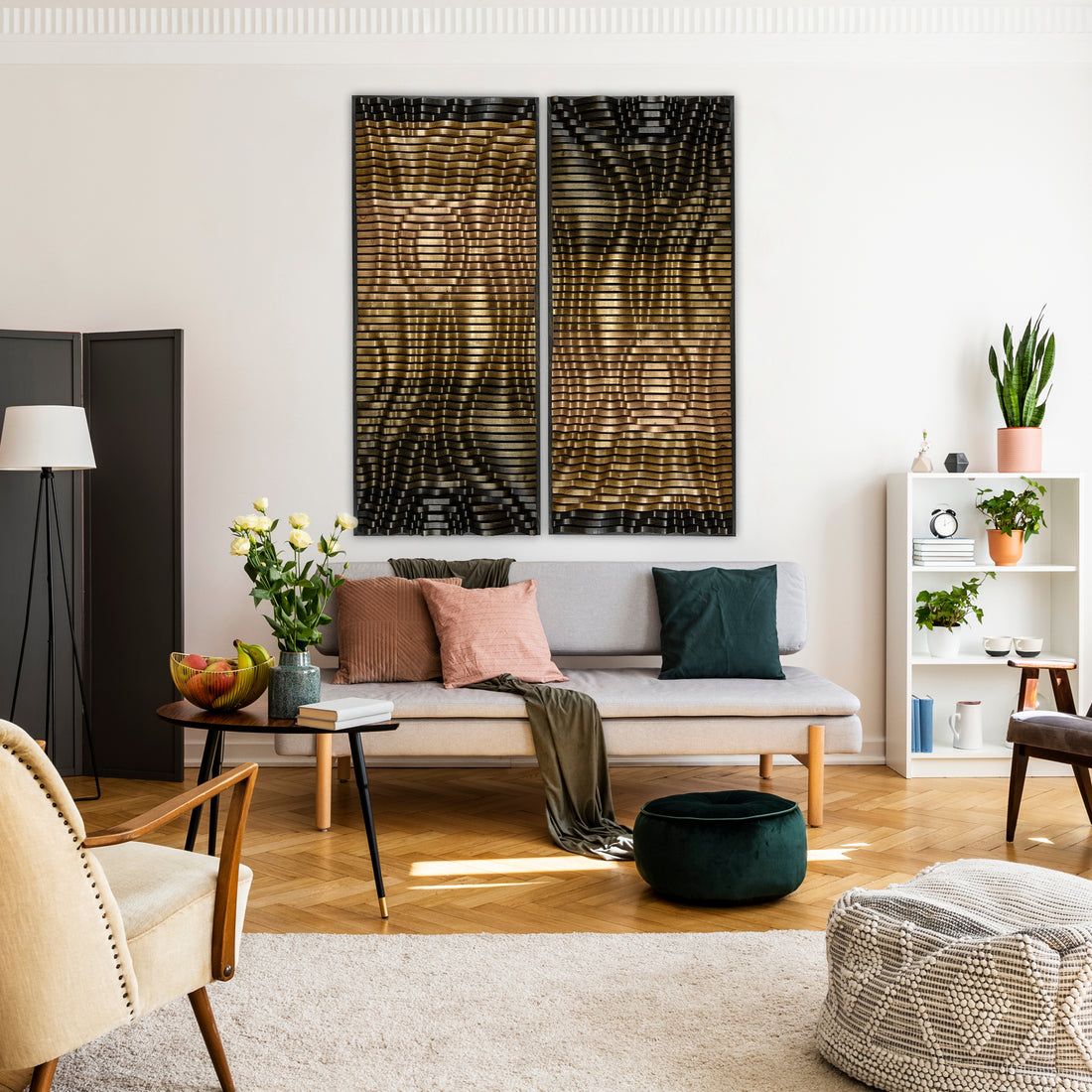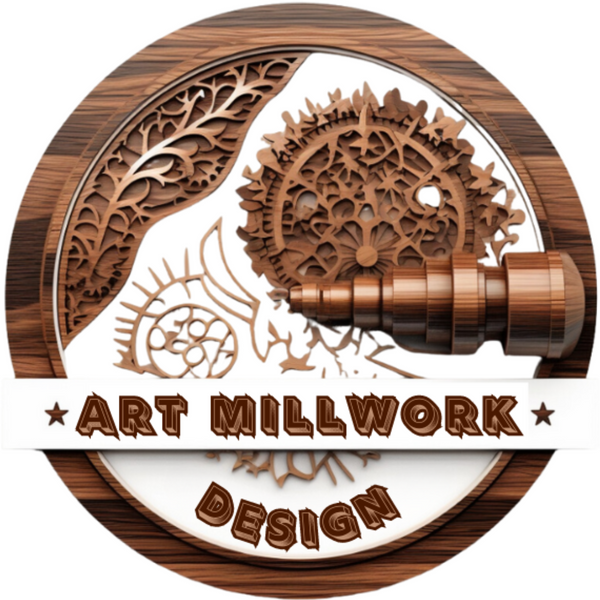
Handcrafting vs. Machine Crafting in Parametric Wood Art: Exploring the Pros and Cons
Share
In the domain of parametric wood artistry, two distinct methodologies stand out: manual craftsmanship and mechanized crafting. Each approach boasts its own array of advantages and constraints, contributing to the distinct character of the final artworks. In this blog post, we delve into the captivating universe of handcrafted and CNC machine-crafted parametric wood art, conducting a comparative analysis of their processes and outcomes.
Handcrafting parametric wood art is an ancient practice that embodies the essence of artistic finesse and skilled craftsmanship. Accomplished artisans painstakingly mold wood using their hands, chisels, and tools. This technique accentuates the intimate rapport between the creator and the medium, resulting in pieces that bear a marked human touch. Handcrafted creations radiate uniqueness, marked by subtle variations stemming from the artisan's personal touch. This distinctiveness renders them exceptional and highly sought-after. Craftsmen enjoy the liberty to improvise, tweak, and adapt designs on the fly, facilitating the infusion of artistic ingenuity and innovation. Handcrafting reveres time-honored woodworking methods, safeguarding ancestral skills passed down through generations. Time and Labor Intensity: Handcrafting demands substantial time and effort for each piece, rendering it a labor-intensive endeavor. This can curtail production capacity and escalate costs. The human factor introduces potential inconsistencies or errors, impacting precision, particularly in intricate parametric designs. Generating substantial quantities of handcrafted pieces poses difficulties due to the time investment required for each creation. On the contrary, Computer Numerical Control machines have spearheaded a revolution in the woodworking domain, enabling impeccable realization of intricate parametric designs. These automated systems follow digital commands, translating intricate patterns into tangible wooden masterworks. CNC machines excel in executing complex designs with unparalleled precision. They consistently reproduce intricate patterns with flawless accuracy. Compared to manual crafting, CNC machines significantly truncate production time, rendering them apt for large-scale endeavors and commercial ventures.
CNC machines adeptly carve intricate patterns that would be exceptionally challenging to replicate by hand. Loss of Artisanal Essence: CNC-crafted pieces might lack the nuanced imperfections and artistic subtleties present in manually crafted counterparts. Operating CNC machines necessitates expertise in programming and machine operation, potentially deterring artisans lacking technical proficiency. CNC crafting adheres rigidly to pre-programmed designs, affording minimal room for impromptu artistic adjustments.
In the ongoing tug-of-war between manual craftsmanship and CNC machine crafting, there exists no definitive victor. Both methodologies possess their niches within the realm of parametric wood art. Manual crafting establishes a human connection and bestows a unique imprint resonating with traditional craftsmanship. Meanwhile, CNC machine crafting facilitates precision and efficiency in the crafting of intricate designs. Ultimately, the choice between these two paradigms hinges on the artist's vision, aspirations, and principles. Some creators might seamlessly amalgamate both techniques, utilizing CNC machines for precise production while incorporating handcrafted nuances for an individualized touch. The fusion of heritage and technology opens avenues for innovation and evolution within the captivating domain of parametric wood art.
Carved wood wall art is a classic choice that brings a sense of elegance and tradition to any space. Each piece is a testament to the skill and artistry of the craftsman, with intricate designs that can range from delicate floral patterns to bold geometric shapes. The beauty of carved wood lies in its ability to add depth and texture to your walls, creating a focal point that draws the eye and adds character to the room.
Carved wood wall art is not only aesthetically pleasing but also carries a sense of history and craftsmanship. Each piece is meticulously crafted, often by hand, ensuring that no two pieces are exactly alike. This uniqueness makes carved wood art a special addition to your home, one that reflects both your personal style and an appreciation for artisanal craftsmanship.
Embracing the Beauty of Nature with Wood Mountain Wall Art
For those who are inspired by the great outdoors, wood mountain wall art is a perfect choice. These pieces often depict stunning mountain ranges, forests, or other natural landscapes, capturing the majesty and serenity of nature. Wood mountain art brings the beauty of the natural world into your home, creating a peaceful and calming atmosphere.
Wood mountain wall art is especially popular in rustic or nature-themed interiors, where it serves as a reminder of the beauty and grandeur of the outdoors. Whether you're decorating a mountain cabin or simply want to bring a touch of nature into your urban home, these pieces are a beautiful way to celebrate the natural world.
The Charm of Handmade Wood Wall Art
Handmade wood wall art is a celebration of craftsmanship and creativity. Each piece is carefully crafted by skilled artisans, resulting in unique works of art that are full of character and charm. The handmade nature of these pieces means that each one is slightly different, offering a personal touch that mass-produced art simply can't match.
Handmade wood wall art can range from simple, minimalist designs to more elaborate and intricate creations. Whether you're looking for something modern and sleek or rustic and textured, handmade wood art offers endless possibilities. These pieces are perfect for adding a touch of individuality to your home, making your space truly one-of-a-kind.
Making a Statement with Large Wood Wall Art
If you're looking to make a bold statement, large wood wall art is the way to go. These pieces are designed to dominate the room, serving as the centerpiece of your décor. Large wood wall art can range from a single, striking piece to a series of panels that together create a dramatic visual impact.
Large wooden wall art works particularly well in spacious rooms with high ceilings, where it can be displayed to its full advantage. Whether it's an abstract design, a detailed landscape, or a bold geometric pattern, large wood art pieces are sure to make an impression. They not only add visual interest to your space but also convey a sense of grandeur and sophistication.
The Versatility of Wood Panel Wall Art
Wood panel wall art is a versatile choice that can adapt to various styles and settings. These panels can be arranged in different configurations, allowing you to create a customized look that suits your space. Whether you prefer a uniform pattern or a more eclectic arrangement, wood panel art offers endless possibilities for creativity and personalization.
Wood panel wall art is available in a variety of styles, from sleek and modern to rustic and textured. This versatility makes it a great option for any room in your home, whether you're decorating a contemporary living room or a cozy bedroom. The natural warmth of wood adds a touch of comfort and elegance to any space, making wood panel art a timeless choice.
Sustainability Meets Style with Reclaimed Wood Wall Art
Reclaimed wood wall art is a beautiful and eco-friendly option that combines style with sustainability. These pieces are made from salvaged wood, often sourced from old buildings, barns, or other structures. The use of reclaimed wood not only gives new life to materials that might otherwise go to waste but also adds a unique, rustic charm to your décor.
Reclaimed wood art often features a weathered, rustic look, with the natural imperfections and history of the wood adding character and authenticity to the piece. Each piece of reclaimed wood tells a story, making your art not just a decoration but a conversation starter. At ArtMillwork Design, our reclaimed wood pieces are crafted with care to highlight the beauty and history of the wood, creating art that is both meaningful and stylish.
The Bold Impact of Big Wooden Wall Art
Big wooden wall art is all about making an impact. These large-scale pieces are designed to be the focal point of a room, drawing attention and creating a strong visual statement. Whether it’s an intricate wood mosaic or a bold geometric design, big wooden art pieces are perfect for those who want to make a dramatic statement with their décor.
When selecting big wooden wall art, it’s important to consider the overall design and color scheme of your room. These pieces should complement your existing décor while standing out as a statement piece. At ArtMillwork Design, our big wooden wall art collections feature a variety of styles, from modern to rustic, ensuring that you can find the perfect piece to elevate your space.
The Artistic Appeal of Wood Mosaic Wall Art
Wood mosaic wall art is a stunning and intricate form of art that involves arranging small pieces of wood into a larger, cohesive design. These pieces are often highly detailed, with each small piece of wood contributing to the overall pattern or image. Wood mosaic art adds texture, color, and complexity to your walls, creating a captivating visual experience.
Wood mosaic wall art is perfect for adding depth and interest to your home. The interplay of different wood tones and textures creates a dynamic and engaging piece of art that draws the eye and invites closer inspection. At ArtMillwork Design, our wood mosaic pieces are handcrafted with care, ensuring that each piece is a work of art in its own right.
Conclusion: Elevate Your Space with Wood Wall Art
Wood wall art is more than just a decorative element; it’s a way to bring the beauty of nature, the skill of craftsmanship, and the warmth of wood into your home. Whether you’re drawn to the intricate designs of carved wood, the rustic charm of reclaimed wood, or the bold impact of large wooden pieces, there’s a piece of wood art that can transform your space. At ArtMillwork Design, we offer a wide range of wood wall art options, each carefully crafted to bring warmth, texture, and beauty into your home. Explore our collection today and discover the perfect piece to elevate your living space.
